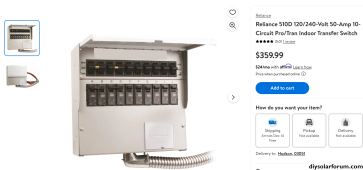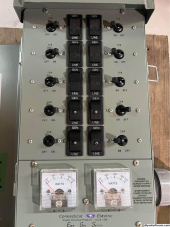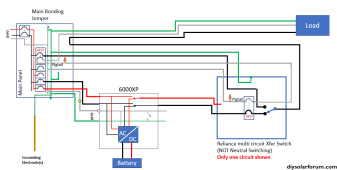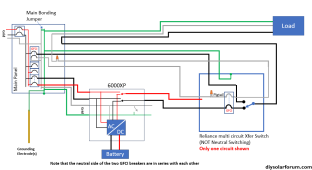rmassuser
New Member
I have a 6000XP coming in a few days and I have some basic questions. My goal is to remove some large loads from my main panel and reduce my electric bill by running these off the 6000XP which will have its own solar panels. There are two ways to do this, as far as I can tell:
1) Permanently remove circuits from the main panel to a critical load panel, i.e. my smaller Mitsubishi heat pump would be the first to go. After that, the water heater. It would free up slots in the main panel.
2) Move circuits to a manual transfer switch instead, so that they can be still run off the main panel, and I can select which ones I want to run off grid. My hunch is that the Municipality will like this better, even if it costs $600 or $700 more because this will keep critical appliances on grid (if my off grid system fails, etc.). Also I might be able to switch more circuits to off grid in the summer when my solar production is higher, and switch them back in winter to the main panel.
Am I correct to assume that the town (and my electrician) would be more favorable to a design that uses the transfer switch INSTEAD of a critical loads panel?
My second question is AFCI/GFCI protection. I have several circuits that require it. However the cost of the AFCI breaker is enormous. $130 for a 2 pole AFCI breaker, 30 amps, and $60 for a 15 amp breaker. I was asked by the inspector to add AFCI to several circuits and GFCI to several others. The cost of the breakers needed for the main panel and also duplicating this for the transfer switch is close to $1000. So I am interested in finding out if I can buy a transfer switch that has some of the AFCI or GFCI breakers pre installed.
The Reliance (see photo from walmart.com) comes with standard breakers including two double-pole ones. Out of the box it takes care of my heat pump and water heater plus 6 additional circuits. Not as much as I want but it's a start. So I am interesting in learning what other products can handle 8 or more of my main home circuits. The manual for the Reliance says that I can swap out their preinstalled breakers and replace them with AFCI or GFCI if needed, so I need to also budget for that cost.
1) Permanently remove circuits from the main panel to a critical load panel, i.e. my smaller Mitsubishi heat pump would be the first to go. After that, the water heater. It would free up slots in the main panel.
2) Move circuits to a manual transfer switch instead, so that they can be still run off the main panel, and I can select which ones I want to run off grid. My hunch is that the Municipality will like this better, even if it costs $600 or $700 more because this will keep critical appliances on grid (if my off grid system fails, etc.). Also I might be able to switch more circuits to off grid in the summer when my solar production is higher, and switch them back in winter to the main panel.
Am I correct to assume that the town (and my electrician) would be more favorable to a design that uses the transfer switch INSTEAD of a critical loads panel?
My second question is AFCI/GFCI protection. I have several circuits that require it. However the cost of the AFCI breaker is enormous. $130 for a 2 pole AFCI breaker, 30 amps, and $60 for a 15 amp breaker. I was asked by the inspector to add AFCI to several circuits and GFCI to several others. The cost of the breakers needed for the main panel and also duplicating this for the transfer switch is close to $1000. So I am interested in finding out if I can buy a transfer switch that has some of the AFCI or GFCI breakers pre installed.
The Reliance (see photo from walmart.com) comes with standard breakers including two double-pole ones. Out of the box it takes care of my heat pump and water heater plus 6 additional circuits. Not as much as I want but it's a start. So I am interesting in learning what other products can handle 8 or more of my main home circuits. The manual for the Reliance says that I can swap out their preinstalled breakers and replace them with AFCI or GFCI if needed, so I need to also budget for that cost.






